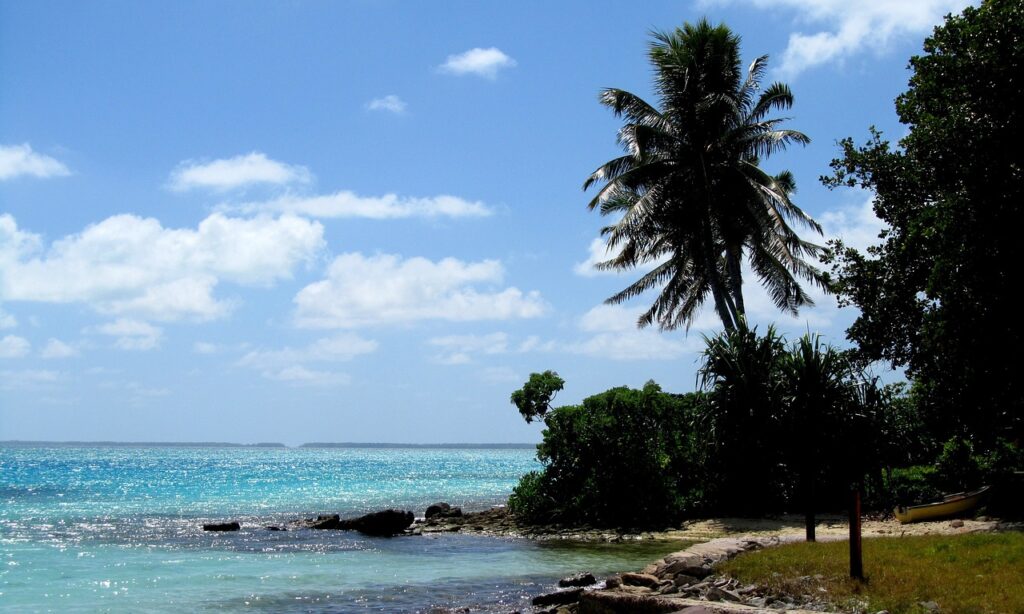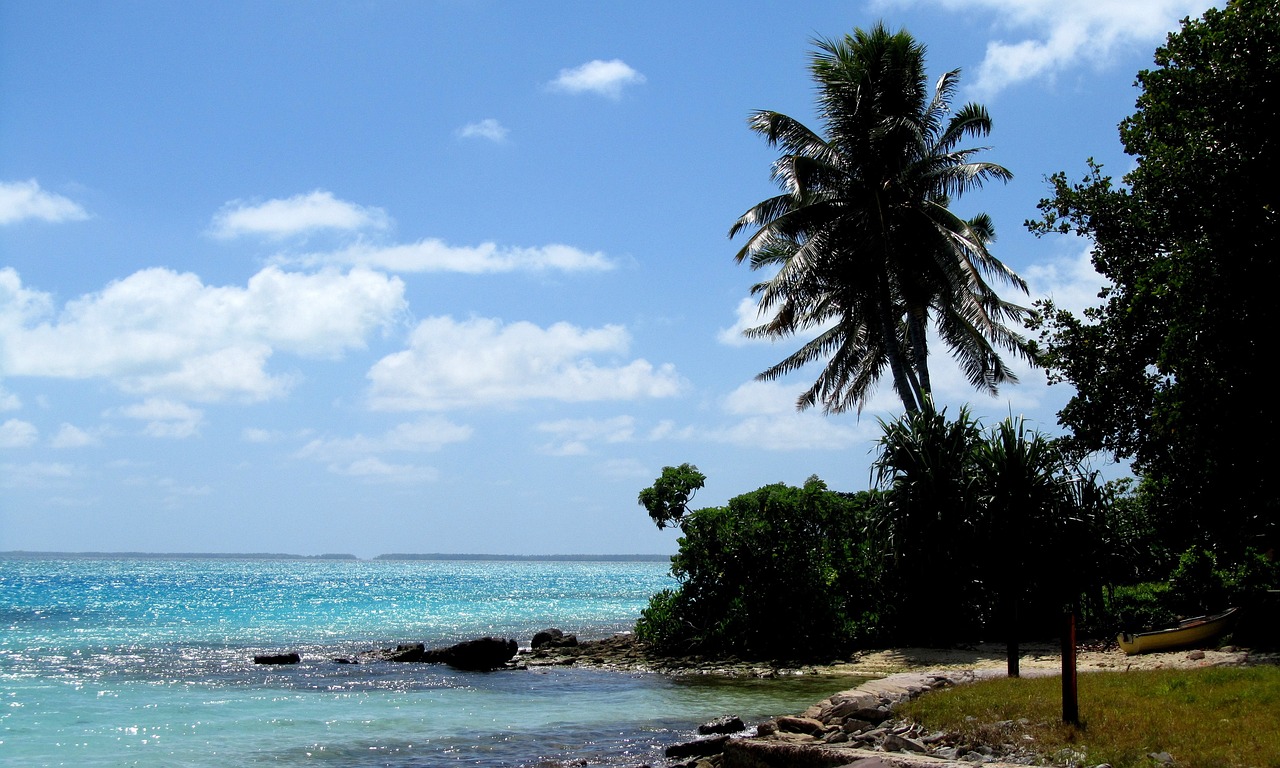
Kiribati is a small island nation located in the central Pacific Ocean. It’s made up of 33 atolls and islands, each one offering its own unique experience. The island country is known for its beautiful beaches, crystal clear waters, and rich marine life, making it a popular destination for travelers looking to experience the true beauty of the Pacific.
One of the main draws of Kiribati is its extensive network of atolls and coral reefs, which provide a haven for marine life and offer some of the best diving and snorkeling opportunities in the Pacific. The Gilbert Islands, which include Tarawa, the capital, are known for their white sandy beaches and vibrant coral reefs. These islands are perfect for those who want to relax and soak up the sun, or for those who want to explore the rich marine life of the Pacific.
Another highlight of Kiribati is its historical significance. The island of Betio, located in the westernmost point of Kiribati, is where the Battle of Tarawa took place during World War II. The Battle of Tarawa was one of the most brutal and bloody battles of the Pacific War, and there are several war memorials and museums on the island that commemorate the event.
Kiribati is also an ideal destination for those looking to experience the traditional Pacific culture. The people of Kiribati are known for their friendliness and hospitality, and visitors can experience traditional customs and practices, such as traditional dance, music, and storytelling.
For hikers and outdoor enthusiasts, Kiribati offers several opportunities to explore the island’s lush tropical forests and pristine beaches. The most popular trek is The Bikenibeu Lagoon Trek, which takes hikers through the dense tropical forests and along the shore of the lagoon, giving hikers a chance to experience the natural beauty of Kiribati.
When planning a trip to Kiribati, it’s important to note that the island nation is not well developed for tourism, so it’s best to bring a sense of adventure and be prepared for some challenges when it comes to accommodations and transportation. With that being said, Kiribati is a destination that is off the beaten path and offers a chance to truly experience the beauty of the Pacific in a unique and remote setting.
Here are some of the landmarks and activities you should check out while visiting Kiribati:
- Christmas Island: This remote atoll is known for its outstanding diving and snorkeling opportunities, with a diverse array of coral reefs and marine life. Visitors can also take a boat tour to see the many seabirds that call the island home, including the red-tailed tropicbird and the sooty tern.
- Tarawa Atoll: As the capital and most populated island of Kiribati, Tarawa offers a glimpse into the local culture and history of Kiribati. Visitors can explore the island’s war memorials and visit the local markets to purchase traditional crafts. Tarawa also has some good options for snorkeling, swimming, and fishing
- Abaiang Atoll: This atoll is known for its traditional Kiribati culture and customs, with several villages that still practice traditional fishing and farming methods. Visitors can also witness the traditional Kiribati dances and songs.
- Butaritari: This atoll is known for its historical significance, as it was the location of several battles during World War II. Visitors can explore the island’s war memorials and visit the local museum to learn more about the history of Kiribati. Butaritari also offers excellent opportunities for diving and snorkeling, and is a great place to witness the marine biodiversity of the Pacific.
- The Phoenix Islands: This group of eight uninhabited islands is a UNESCO World Heritage site and offers a truly remote and unspoiled natural environment. Visitors can explore the islands’ coral reefs, lagoons, and marine life, and even take a guided tour to see the many seabirds and sea turtles that call the Phoenix Islands home.
- The Kiribati National Museum: This is one of the most visited places in Kiribati, which provides visitors with a glimpse of the island’s history and culture, showcasing traditional artifacts, including fishing equipment, canoe models, and historic photographs.
- Kiribati National Stadium: is one of the main landmark of the island, it’s a popular spot for locals to gather for sports events, especially for soccer games. Visitors can also enjoy a concert or a performance there.
It’s worth noting that many of the activities and landmarks in Kiribati revolve around its natural beauty and marine life, making it a popular destination for diving, snorkeling, and fishing. However, visitors should also take the opportunity to learn about the island’s unique culture and history, which offer a window into the traditional way of life of the Kiribati people.
Food
Kiribati cuisine is influenced by the island’s location in the Pacific Ocean, as well as its history as a British colony. The local diet is based on seafood, coconuts, and root vegetables, with a focus on simple, fresh ingredients.
Here are some must-eat dishes in Kiribati:
- Sashimi: Freshly caught fish and seafood is a staple in Kiribati, and sashimi is a popular way to enjoy it. The fish is often marinated in lime juice and served with a side of sliced onion and ginger.
- Poke: This traditional Kiribati dish is made from raw fish that is diced and mixed with lime juice, coconut milk, and sometimes onions and tomatoes. It’s similar to ceviche and is usually served as an appetizer.
- Ika mata: This is a classic dish of raw fish that is marinated in lime juice, coconut milk, and tomatoes, often served with mashed taro or breadfruit.
- Uumu: This is a traditional dish made by baking fish, chicken, or pork wrapped in taro leaves in an underground oven called an umu.
- Pandanus Cake : A traditional dessert made from the leaf of the pandanus plant, usually flavored with coconut milk and sweetened with sugar. It’s a sweet and delicious treat.
- Uvi: A staple of the Kiribati diet, uvi is a root vegetable that is often cooked in coconut milk, or boiled and served with fish.
When to go to Kiribati
The best time to visit Kiribati depends on what you’re looking to get out of your trip. The island nation has a tropical climate, with warm temperatures year-round and high humidity. However, there are a few things to keep in mind when planning your trip.
- Dry Season: The dry season runs from May to October, and is considered the best time to visit if you’re looking to avoid the rain and enjoy clear skies. This is also the best time for activities such as swimming, snorkeling, and diving.
- Wet Season: The wet season runs from November to April, and is considered the best time to visit if you’re looking to see the lush green landscapes of Kiribati. It’s a great time for hiking and exploring the islands’ nature. However, heavy rain and strong winds are to be expected during this period.
- Peak Season: December to January is considered the peak tourist season, when the weather is most stable, and many travelers visit the island. This time may be considered the best time to visit if you’re looking for the most comfortable conditions and more touristic amenities.
Keep in mind that Kiribati is a remote destination and its infrastructure may be limited. It’s best to plan ahead and be prepared for any weather conditions.
In general, Kiribati has a mild climate all year round, with the best weather conditions to be found in the dry season, which lasts from May to October.
